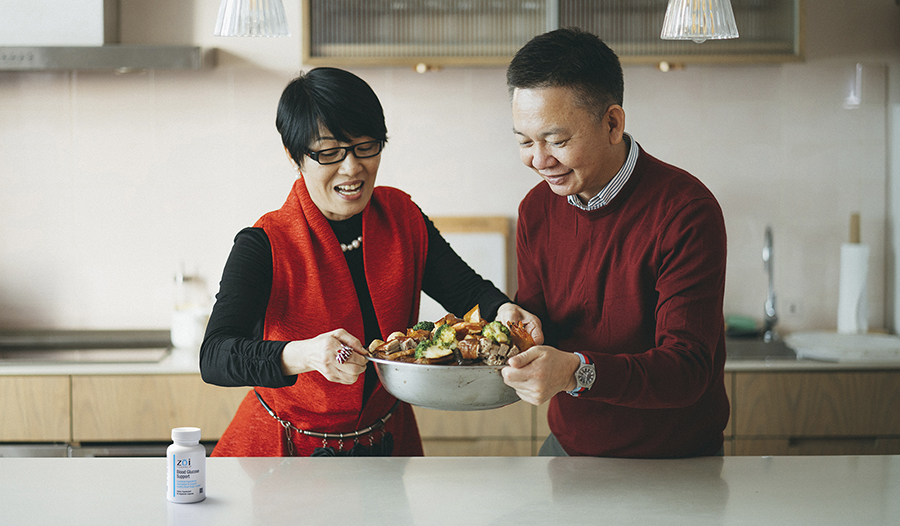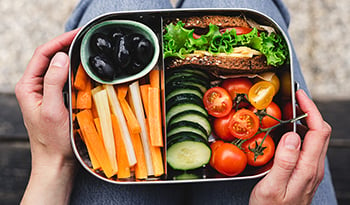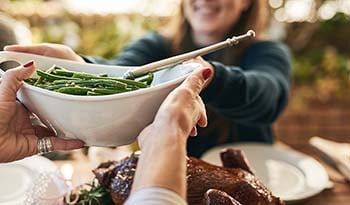Healthy Holiday Meals that Don’t Hurt Blood Sugar
DISCLAIMER:This blog does not intend to provide diagnosis...
- In this article:
- Why Blood Sugar Is Important
- Holiday Meals that Don’t Hurt Blood Sugar

The holidays are coming up, and you’re probably wondering what healthy, delicious things you can make for your loved ones that not only nourish their souls but also their bodies! This becomes even more important if you or your loved ones have blood sugar issues, as some typical tasty holiday treats can hurt blood sugar levels and leave them feeling not-so-sweet.
Here are some of my favorite holiday meals and treats that minimize artificial sugars and take advantage of the science around macros, fiber, glycemic index, and glycemic load to keep insulin levels normal while you feast.
Why Blood Sugar Is Important
If you or a loved one struggles to manage blood sugar levels, then you may have come to assume that eating any sugar at all is bad, including sugars from fruits and starches from vegetables, but that’s simply not true! Not all sugars are bad for you. To understand this concept, let’s review some basic human biology and nutrition science. After that, we’ll get to the recipes!
Your Cells Run on Sugar
Every cell in your body runs on glucose. When you deprive your cells of glucose, they are not able to create the energy they need to run the over 500 biochemical reactions that happen in your body each day. What results are symptoms of hypoglycemia and low energy, including fatigue, brain fog or slowed and muddled thinking, weakness, shaking, and even emotional symptoms like sadness and irritability. Not fun, to say the least!
You can see that sugar is important for our survival and wellbeing from the examples above, so what are we actually talking about when we talk about the need to manage blood sugar? Our hormones like insulin, leptin, ghrelin, and more.
Hormones and Habits Contribute to Blood Sugar Issues
If you have insulin resistance or inadequate insulin production—as occurs in Type 2 and Type 1 diabetes, respectively—then your cells don’t get enough sugar even if you eat the right amount of sugar each day. This is because insulin is the biochemical key that unlocks our cells and allows them to absorb the sugar we eat. Without insulin, cells can’t accept glucose from the blood, and we feel hypoglycemic even after we’ve eaten enough. So, the problem isn’t so much sugar as it is insulin.
Insulin is a hormone and its production and function can be altered over time by certain diseases and lifestyle habits. Type 2 diabetes can often be reversed with a combination of medications, lifestyle approaches, and diet. Type 1 diabetes cannot be reversed and requires pharmaceutical management with insulin. For the purposes of the rest of the article, we’ll talk about lifestyle and dietary habits that can help someone who makes a normal amount or too much insulin.
If you have any type of diabetes, run any dietary changes by your RD, endocrinologist, or other specialists before making drastic changes to your diet. If you’re looking to reverse what your doctor has told you is “high blood sugar” then the recipes and ideas below will help you do just that.
Glycemic Index and Glycemic Load Matter Most
Did you know that there’s a secret code that will allow you to still eat sugar and starch without affecting your blood sugar drastically? It’s called the glycemic index or glycemic load. Glycemic index compares the way that a food affects blood sugar compared to glucose. The higher the glycemic index, the more sugary a food is and the more likely it is to quickly spike your blood sugar.
High glycemic index foods include white bread, white rice, and cane sugar. Low glycemic index foods include many green vegetables, nuts, and seeds.
The following meals and snacks include mostly low glycemic foods to help keep you healthy while still feeling like you ate your fill!
Holiday Meals that Don’t Hurt Blood Sugar
Healthy Side Dishes: Roasted Veggies
Many people love the taste of roasted corn, Brussels sprouts, asparagus, broccoli, carrots, and more, but forget to make these sides in the business of focusing on the main course. Most vegetables have an incredibly low glycemic index/glycemic load score because they are low in sugar, high in fiber, and moderate in starch. Even more importantly, they’re packed full of nutrients like vitamins and minerals that we need to keep our immune systems, cardiovascular systems, and skin healthy.
While butter is not high in sugar, it’s ultimately a food that is high in calories, saturated fat, and usually salt. Try to roast with as little oil or butter as possible, and consider tools like a silicone baking mat to avoid the use of them entirely.
Try the following combinations to make sides that disappear like magic after you put them out:
- Brussel sprouts and bacon slices
- Carrots roasted with thyme and/or fennel
- Roasted potatoes covered in Italian seasoning (usually oregano, thyme, and basil)
- Roasted corn with hot red peppers
- Roasted asparagus with garlic and lemon
Hors d'oeuvres, Crudités, and Charcuterie Boards
Many people opt to serve hors d'oeuvres, crudités, and charcuterie before the main course. This allows folks to munch on fairly healthy snacks while they wait for food to cook, and to socialize on a not-empty stomach, which always makes for better conversation! Much of the food served on charcuterie boards is already low-glycemic, including:
- Fresh vegetables
- Olives
- Sliced meats
- Nuts
- Roasted peppers and preserved vegetables like onions or garlic
- Dips made with beans and lentils
I advise folks to center the board around these items and also to include fresh fruit (not dried), while leaving out dairy, crackers, cheeses, and spreads, which can increase caloric intake and spike blood sugar. You might be surprised to hear that dairy can increase blood sugar, but there’s research that shows that cow dairy can spike insulin levels more than cane sugar, which gives it a higher glycemic index. For that reason, I have folks that have difficulty managing their blood sugar avoid or limit dairy products.
Meat and Veggies
Turkey and asparagus, beef and green beans, chicken, and roasted broccoli… all of these are great recipe ideas for folks who eat meat and who are looking to keep their blood sugar under control during the holidays. Meat is always low glycemic unless you add breading, toppings, or sauces that contain carbs or sugar. For that reason, I recommend grilling meat or roasting it in a pan with vegetables to keep the sugar content low.
Beans and Lentils
Bean and lentil dishes are low glycemic despite having carbohydrates because they are so high in fiber. Try a lentil loaf instead of meatloaf, or a white bean and spinach salad with a chickpea pasta for your main course to increase your fiber content while also enjoying a tasty treat.
Healthy Desserts
Cinnamon Sweet Potato Mash: This easy-to-make recipe only has 5 grams of sugar and 14 net carbs per serving. To make it, simply roast 4-5 small whole sweet potatoes in the oven after cleaning them. Poke several holes in them to allow air to escape while they cook, and leave the skin on for extra fiber and nutrients. I usually bake mine at 450 degrees for about 45 minutes. When roasted, pull out of the oven and mash. You can also mix them in a food processor if this is easier. Once mashed, add spices like cinnamon or pumpkin pie spice mix to the sweet potatoes until it reaches a taste you enjoy. If it's not sweet enough for your liking, you can add a non-calorie sweetener like stevia to taste. You can serve this mash hot or cool. It’s a party favorite and serves about 8-10 people.
Coconut Chia Seed Pudding: Chia seed puddings are a go-to when it comes to making tasty desserts that add more nutrients than sugar to your day. They all start out basically the same; a few tablespoons of chia seeds, a cup or two of non-dairy milk, some stevia, and some fruit. You can flavor them with vanilla, cacao powder, cinnamon, and more to make the relatively tasteless base into any flavor you’d like. You can even add some peppermint to a cocoa-flavored chia seed pudding to make a tasty treat that’s almost like mint chocolate chip ice cream but without the sugar.

 By Dr. Kate Henry, N.D.
By Dr. Kate Henry, N.D.


